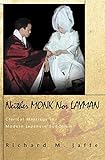Neither Monk nor Layman : Clerical Marriage in Modern Japanese Buddhism / Richard M. Jaffe.
Material type: TextSeries: Buddhisms: A Princeton University Press Series ; 14Publisher: Princeton, NJ : Princeton University Press, [2021]Copyright date: ©2002Description: 1 online resource (320 p.) : 7 b/w illusContent type:
TextSeries: Buddhisms: A Princeton University Press Series ; 14Publisher: Princeton, NJ : Princeton University Press, [2021]Copyright date: ©2002Description: 1 online resource (320 p.) : 7 b/w illusContent type: - 9780691231099
- RELIGION / Buddhism / General (see also PHILOSOPHY / Buddhist)
- Agonshū
- Akizuki Tanetatsu alcoholic beverages
- Andō Yoshinori
- Arai Nissatsu
- Butsuryūkō
- Chadwick, David
- Chiba Shunrei
- Chūsonji
- Daichidoron
- Date Mitsuyoshi
- Eiheiji
- Enmeiin Incident
- Fleming, William
- Fukase Shunji
- Fukushima Masao
- Genkaku
- Haga Shōji
- Harunasan
- Hirata Atsutane
- Honganji
- Inoue Enryō
- Ishida Mizumaro
- Iwakura Tomomi
- Jainism
- Jizō bodhisattva
- Kaimyōji Shōtsū
- Kamei Koremi
- Kawamura Seiji
- Kita Sadakichi
- Kuroda Kiyotsuna
- Kōsen Mujaku
- Manase Gensaku
- Mappō tōmyōki
- Matono Hansuke
- Matsudaira Yoshinaga
- Mokuan shōtō
- Morioka Kiyomi
- Nagayama Kōryū
- Okamoto Yasutaka
- Ototachibana Hime
- Reiyūkai
- Rengekai
- Ryōken
- Sasaki Gihan
- Seikaku
- civil society
- dispensationalism
- evolutionary theory
- human rights
- imperialism, Japanese
- lay bodhisattvas
- military draft
- Ōhara Shigetomi
- 294.3/61
- online - DeGruyter
| Item type | Current library | Call number | URL | Status | Notes | Barcode | |
|---|---|---|---|---|---|---|---|
 eBook
eBook
|
Biblioteca "Angelicum" Pont. Univ. S.Tommaso d'Aquino Nuvola online | online - DeGruyter (Browse shelf(Opens below)) | Online access | Not for loan (Accesso limitato) | Accesso per gli utenti autorizzati / Access for authorized users | (dgr)9780691231099 |
Frontmatter -- Contents -- Figures and Table -- Preface -- Acknowledgments -- Reference Abbreviations -- Ministries and Other Government Institutions -- NEITHER MONK NOR LAYMAN -- Chapter 1 Introduction -- Chapter 2 Pre-Meiji Precedents -- Chapter 3 Jôdo Shin Buddhism and the Edo Period Debate over Nikujiki Saitai -- Chapter 4 The Household Registration System and the Buddhist Clergy -- Chapter 5 Passage of the Nikujiki Saitai Law: The Clergy and the Formation of Meiji Buddhist Policy -- Chapter 6 Horses with Horns: The Attack on Nikujiki Saitai -- Chapter 7 Denominational Resistance and the Modification of Government Policy -- Chapter 8 Tanaka Chigaku and the Buddhist Clerical Marriage: Toward a Positive Appraisal of Family Life -- Chapter 9 The Aftermath: From Doctrinal Concern to Practical Problem -- Chapter 10 Almost Home -- Glossary -- Bibliography -- Index
restricted access online access with authorization star
http://purl.org/coar/access_right/c_16ec
Buddhism comes in many forms, but in Japan it stands apart from all the rest in one most striking way--the monks get married. In Neither Monk nor Layman, the most comprehensive study of this topic in any language, Richard Jaffe addresses the emergence of an openly married clergy as a momentous change in the history of modern Japanese Buddhism. He demonstrates, in clear and engaging prose, that this shift was not an easy one for Japanese Buddhists. Yet the transformation that began in the early Meiji period (1868-1912)--when monks were ordered by government authorities to adopt common surnames and allowed to marry, to have children, and to eat meat--today extends to all the country's Buddhist denominations. Jaffe traces the gradual acceptance of clerical marriage by Japanese Buddhists from the premodern emergence of the "clerical marriage problem" in the Edo period to its widespread practice by the start of the Second World War. In doing so he considers related issues such as the dissolution of clerical status and the growing domestication of Japanese temple life. This book reveals the deep contradictions between sectarian teachings that continue to idealize renunciation and a clergy whose lives closely resemble those of their parishioners in modern Japanese society. It will attract not only scholars of religion and of Japanese history, but all those interested in the encounter-conflict between regimes of modernization and religious institutions and the fate of celibate religious practices in the twentieth century.
Mode of access: Internet via World Wide Web.
In English.
Description based on online resource; title from PDF title page (publisher's Web site, viewed 24. Aug 2021)


